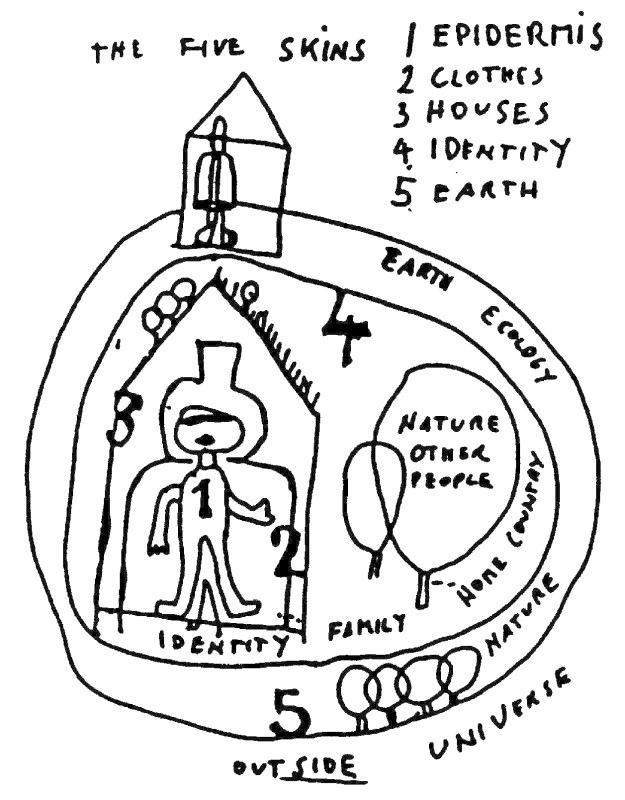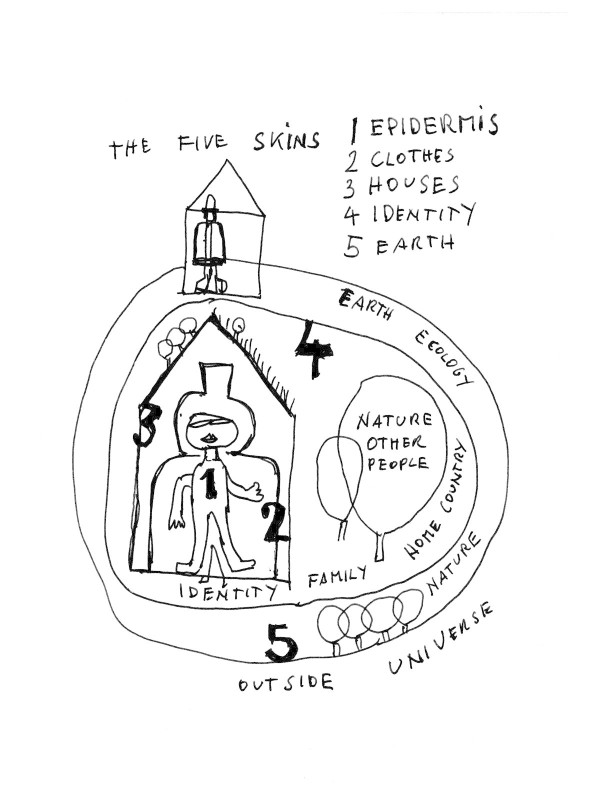Hundertwasser conceived this drawing for the book The Power of Art, Hundertwasser - The Painter-King with the five skins, Cologne, by Pierre Restany, published by TASCHEN Verlag in Cologne in 1998.
The pictogram represents the five spheres around which Hundertwasser's concerns revolve, and thus the five chapters of the book.
The first skin: The epidermis
The second skin: The clothes
The third skin: Man's houseThe fourth skin: The social environment and the identity
The fifth skin: The global environment - ecology and mankind
"
Since painting his first spiral in 1953, in the studio of his friend René Brô, Hundertwasser had sealed his vision of the world and of his relationship with exterior reality. It was a relationship forged by osmosis, starting from successive levels of consciousness, and concentric to his inner self. The pictorial symbol illustrated the biological metaphor. For Hundertwasser, man has three skins: his natural epidermis, his clothes, his house. When in 1967 and 1968 the artist delivered his "Naked" adress to proclaim man's right to his third skin (the free alteration of his house), he accomplished the ritual full cycle of his spiral. He re-found his first skin, that of his original truth, his nakedness as a man and painter, by stripping off his second skin (his clothes) to proclaim the right to his third skin (his home). Later, after 1972, when the major ideological turning-point had been passed, the spiral of Hundertwasser's chief concerns began to unfold. His consciousness of being was enriched by new questions, which called fresh responses and elicited new commitments. So appeared the new skins that were to be added to the concentric envelopment of the three previous ones. Man's fourth skin is the social environment (of family and nation, via the elective affinities of friendship). The fifth skin is the planetary skin, directly concerned with the fate of the biosphere, the quality of the air we breathe, and the state of the earth's crust that shelters and feeds us.
"
(Pierre Restany, in: The Power of Art, Hundertwasser - The Painter-King with the five skins, Cologne, 1998, pp. 10-11)
- W. Schmied, Hundertwasser 1928-2000, Catalogue Raisonné, Cologne, 2000, Vol. I, p. 395 (b)
- A. C. Fürst, Hundertwasser 1928-2000, Catalogue Raisonné, Cologne, 2002, Vol. II, pp. 1137/1138 (and b), 1140/1141
- Briefmarkenbuch, Vienna, 2008, (b)
- Regentag-Wassergläser für das Leben, Vienna, 2011, p. 26 (b, German and English edition)
- Caixa Cultural Brasília and Salvador, 2009 (b)
- HW-Die Kunst des grünen Weges, KunstHausWien, Vienna, 2011, pp. 198 (b), 215
- Dans la peau de Hundertwasser, Le Musée en Herbe, Paris, 2013, p. 14 (b)
- De Derde Huid, Museum De Buitenplaats, Eelde, 2014/2015, p. 14 (c)
- Caixa Cultural Brasília and Salvador, 2009 (b)
- HW-Die Kunst des grünen Weges, KunstHausWien, Vienna, 2011, pp. 198 (b), 215
- Dans la peau de Hundertwasser, Le Musée en Herbe, Paris, 2013, p. 14 (b)
- De Derde Huid, Museum De Buitenplaats, Eelde, 2014/2015, p. 14 (c)
- Caixa Cultural Brasília and Salvador, 2009 (b)
- HW-Die Kunst des grünen Weges, KunstHausWien, Vienna, 2011, pp. 198 (b), 215
- Dans la peau de Hundertwasser, Le Musée en Herbe, Paris, 2013, p. 14 (b)
- De Derde Huid, Museum De Buitenplaats, Eelde, 2014/2015, p. 14 (c)
- Caixa Cultural Brasília and Salvador, 2009 (b)
- HW-Die Kunst des grünen Weges, KunstHausWien, Vienna, 2011, pp. 198 (b), 215
- Dans la peau de Hundertwasser, Le Musée en Herbe, Paris, 2013, p. 14 (b)
- De Derde Huid, Museum De Buitenplaats, Eelde, 2014/2015, p. 14 (c)
- G. Eisenhut, Einfach geniale Kunstprojekte, Neuried, 2004, p. 13 (b)
- St. Pelloni, Hundertwasser, un incontro magico, Ravenna, 2010 (b)
- M.-H. Caraës / N. Marchand-Zanartu, Images de pensée, Paris, 2011, p. 78 (b)
- L. Barbosa, Design sem fronteiras, São Paulo, 2012, p. 207 (b)
- E. Gustke, Das Blaue vom Himmel, Saarbrücken, 2016, pp. 11-12
- Dossier pédagogique, Musée de Millau et des Grands Causses, 2018, p. 3 (b)
- RL, no. 2, 2006, Zurich, p. 26 (b)
- Deutsches Yoga-Forum, no. 6, 2008, Göttingen, p. 22 (b)
- G. Salazar, Loclizacion del diseno ecologico, Revista 180, no. 31, 2013, p. 44, 47 (and b)
- T-shirt, graphis inc., Tokyo, 2012
- T-shirt, graphis inc., Tokyo, 2012
- T-shirt, graphis inc., Tokyo, 2012
- T-shirt, graphis inc., Tokyo, 2012

